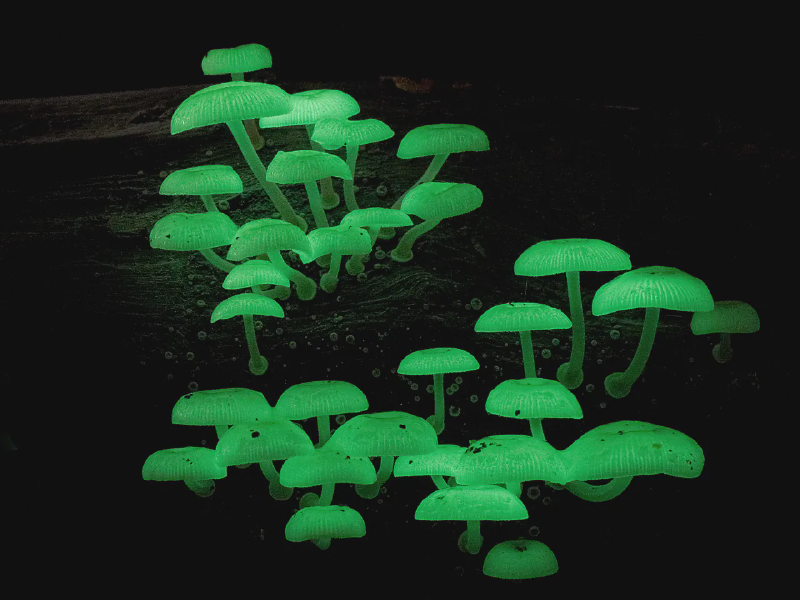A year ago or so, I watched Fantastic Fungi on Netflix, and then I watched BBC Earth’s amazing Planet Earth series (I, II and III) and some other great documentaries that sometimes featured mushrooms and Fungi. That sparked an inexplicable passion for those organisms, so I read about them and watched more stuff, and went out in the wild looking for them. So I decided to write about them here to share the ❤️ for those little guys, and for the Natural World right around us. So there we go for a fungi-themed series of stories !
Discreet and mysterious, fungi (or mushrooms) are the most underappreciated kingdom of the natural world, and yet they are absolutely essential to all Life on Earth and amazingly interesting to study. Although they rank relatively low on the biological charisma scale, fungi play essential roles in ecological communities and form a a truly spectacular yet little-known world.
Today our world is visually dominated by animals and plants, but this world would not have been possible without fungi, say University of Leeds scientists.
We all know plants are the primary producers of energy (organic matter like sugar) through photosynthesis. They are the basis of ecosystems since other organisms (herbivores) obtain energy by eating them. As we’ll see, Fungi play a central role for plant life
I. Fungi made fertile soil for plants to thrive on
Neither plant nor animal, fungi have been around since the dawn of life. It was fungi that made life possible on a desolate planet. They ate rocks which made soil that allowed plants to colonize land. That changed the climate, sparking the evolution of animals.
Fungi played a critical part in establishing the breathable atmosphere on Earth by “mining” essential nutrient minerals like phosphorus from rocks and transferring them to plants to make photosynthesis and plant growth possible.
While most modern plants can gather their nutrients directly from soils through roots, early plant life faced an entirely different environment, did not have roots and was non-vascular, meaning they could not hold water or move it around their system.
Fungi have the ability to extract minerals from the rocks they grow on through a process known as biological weathering. The fungi express organic acids which help to dissolve the rocks and mineral grains they grow across.
By extracting these minerals and passing them on to plants to aid the plants’ growth, the fungi in return received the carbon the plants produced as they photosynthesis carbon dioxide from the atmosphere using daylight energy.
II. Fungi helped photosynthetic organisms colonize Earth
A lichen is a composite organism that emerges from algae or cyanobacteria living among the filaments of a fungi in a mutually beneficial symbiotic relationship. The fungi benefit from the carbohydrates (sugars) produced by the algae or cyanobacteria via photosynthesis. The algae or cyanobacteria benefit by being protected from the environment by the filaments of the fungi, which also gather moisture and nutrients from the environment, and (usually) provide an anchor to it (Wikipedia).

It is estimated that 6–8% of Earth’s land surface is covered by lichens. Scientists think that Fungi played an important role in the transition of plants from water to land habitats by providing essential shelter and nutrients.
Symbiosis between plants and fungi is extremely widespread in Nature, and comes in several forms.
III. 90-95% of plants live in a relationship with some fungi
Here is a surprisingly little known fact: 95% of plant species live in a strong symbiotic relationship with fungi. It all happens underground, between fungal filaments (mycelium hyphae) and plant root and it’s called mycorrhiza:
- Plants give carbohydrates (sugars)
- Fungi provide water and minerals, and enable plant chemical communication

In the case of endomycorrhizae, the relationship is so strong that the fungi filaments grow inside the plant cells. This subterranean network, nearly 500 million years old and linking plants through Fungi is also called the World Wide Wood.
IV. Fungi helped mammals rise after dinosaurs disappeared
This one is surprisingly little known too.
65 million years ago, a big volcanic episode combined with an asteroid strike would wipe out 70%of all Earth life. But it didn’t happen all at once: the lack of sunlight that followed meant that the plant life that didn’t die first would start to decay, creating great conditions for fungi to spread.
When that happened, mammals had one key advantage over cold-blooded reptiles, Earth’s dominant life forms at that time.
“They’re hot,” explains Arturo Casadevall, a professor of public health at Johns Hopkins University. “The reptiles are quite susceptible to fungal diseases, but your typical mammal, which maintains a temperature in the mid 30’s or so, creates a thermal exclusionary zone for fungi.”
Fungi are believed to have helped a lot with the extinction of reptiles (like dinosaurs), freeing space for the rise of the first mammals. Those same mammals are the ancestors of every mammal on the planet today, from pandas to whales to us humans.
“The warm-bloodedness of mammals, including ourselves, has evolved, in part, as a response to the pressure from fungus,” says Rob Dunn, a professor at North Carolina State University. “And so we seem to have cooked out the fungal pathogens.”
Fungi are part of the reason we exist.
V. They are master decomposers
Without fungi to aid in decomposition, Earth would soon be buried under a mountain of dead matter.
“Fungi are the garbage disposal agents of the natural world,” according to Cardiff University biosciences professor Lynne Boddy. “They break down dead organic matter and by doing that they release nutrients and those nutrients are then made available for plants to carry on growing.”
“It’s how everything is reborn,” says Dunn. “So that this entire web of life is connected and it’s connected through the fungi.”
In short, fungi eat dead things, and in doing so, create new life.
Some fungi can even “decompose” or at least concentrate organic pollutants, plastic, radioactive materials or even oil.
